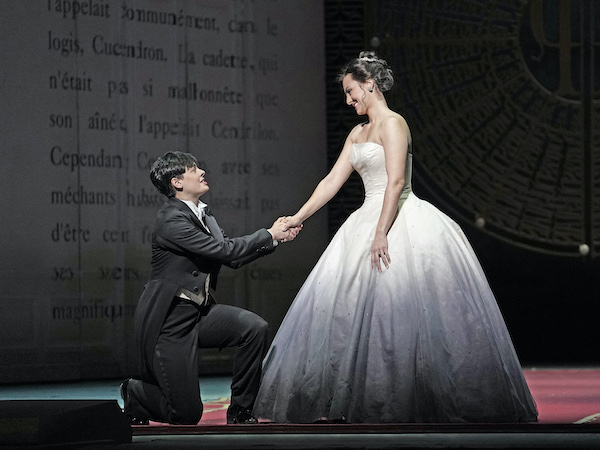Met’s slenderized “Cinderella” lighter on gentle charm than comedic camp

The Metropolitan Opera’s production of Cinderella—offered as an easily-digestible holiday treat for families—opened on Friday night to a lukewarm reception from the near-capacity audience.
This production is a newly abridged English-language version of Massenet’s Cendrillon, adapted from the Laurent Pelly staging first seen at the Met in 2018. With its whimsical costumes and comical dancing and pantomimes, the show tried hard for laughs, and earned a few. But after the final curtain, it was touch-and-go whether the audience would sustain its applause long enough for the cast to find its places backstage for the curtain call.
Let’s allow for the possible presence of classical-music newbies unfamiliar with the custom of clapping for a long time after a performance. (Downstairs in the house at least, the senior demographic didn’t seem to differ much from any other night at the Met.)
But it’s also true that this trimmed version of the score played more like a movie trailer for an opera than like an opera—hitting a few vocal highlights and checking off the plot points of this familiar story, but rarely engaging the listener emotionally. Without that engagement, it was hardly the kind of commercial for the art form the company might have been hoping for.
But opera-as-eyeful was well represented in Pelly’s costumes for his fanciful production, the full-length version of which has been around since it was unveiled at Santa Fe Opera in 2006. Alternately Louis XIV and Belle Époque with touches of Tenniel’s Alice in Wonderland and Dr. Seuss, the crazy fashion show reached its climax in the parade of would-be princesses before the apathetic Prince Charming, each more bizarrely garbed than the last. Laura Scozzi’s eccentric court dances for the full company added yet another layer of visual goofiness to the scene.
In contrast, the set by Barbara de Limburg was simplicity itself, movable flat walls with lots of tall doors suggesting alternately a country house or a palace. The French text of Perrault’s original Cinderella story covered the walls, a constant reminder that one was watching a fairy tale, not verismo.
In the scramble to make an impression before the curtain came down, the most successful portrayals were of the most two-dimensional characters. Stephanie Blythe got the most laughs of the evening as the battleaxe-and-loving-it Madame de la Haltière, in a bulked-out costume with a formidable voice to match. With matched piping voices and mincing gaits, Jacqueline Echols and Maya Lahyani as Madame’s daughters Naomie and Dorothy were flibbertigibbets par excellence.
Laurent Naouri played Madame’s henpecked husband Pandolfe more naturalistically, the better to win sympathy for his character, especially in tender moments with his daughter Cinderella. His immaculate English diction and forward-placed baritone seemed to invite the audience in.
Jessica Pratt played the Fairy Godmother with panache, as a worthy adversary to the scheming Madame de la Haltière, even with a sparkly coloratura that was more Fledermaus than Queen of the Night.
With less music to work with and their scene in the woods cut entirely, the romantic leads had their work cut out for them to convey character and motivation. Isabel Leonard’s fetching looks and radiant, legato singing as Cinderella went a long way toward winning the audience over. Her way of flicking a pianissimo high note went right to the heart.
Although the role is known to fly high for mezzo-sopranos, enough of it was cut so that when Cinderella departed for the ball with a burst of coloratura staccato and a sustained high A, it came as a shock.
Mezzo-soprano Emily D’Angelo as Prince Charming phrased somewhat stiffly in a reedy, buzzy voice that made the character’s ardor for his new love somewhat inscrutable. Her portrayal of the Prince as a pouty adolescent fit the comical tone of the production, but inhibited the role’s emotional tug.
The evening saw some solid Met debuts in smaller roles, beginning with Matthew Anchel as the Master of Ceremonies and Jonah Hoskins as the Dean. (Paul Corona as the Prime Minister rounded out the trio of worried officials trying to get the depressed Prince out of bed.) Michael Sumuel made his company bow with energy and a robust basso as the King.
Massenet’s score spins fairy magic with piccolo, harp, percussion and staccato strings, but the effect requires pinpoint timing among players and singers, which came and went Friday night under conductor Emmanuel Villaume. The French maestro, usually a reliable hand in his native repertoire, led an energetic but somewhat heavy-footed performance overall.
Kelley Rourke is credited in the program only for “English translation,” but advance materials from the Met indicate she supervised the abridgment process as well. Her translation rhymed easily and preserved much of librettist Henri Cain’s satirical wit, but the cuts (inevitably, perhaps) did no favors for his artful dramatic structure.
Cinderella runs through January 3. metopera.org.






